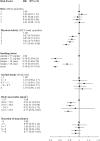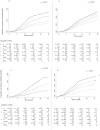Association Between the Healthy Lifestyle Index and Risk of Multimorbidity in the Women's Health Initiative
- PMID: 37463321
- PMCID: PMC11491747
- DOI: 10.1093/gerona/glad170
Association Between the Healthy Lifestyle Index and Risk of Multimorbidity in the Women's Health Initiative
Abstract
Background: Multimorbidity, defined as the presence of 2 or more chronic health conditions, is increasingly common among older adults. The combination of lifestyle characteristics such as diet quality, smoking status, alcohol intake, physical activity (PA), sleep duration, and body fat as assessed by body mass index (BMI) or waist circumference, and risk of multimorbidity are not well understood.
Objectives: We investigated the association between the healthy lifestyle index (HLI), generated by combining indicators of diet quality, smoking, alcohol, PA, sleep amount, and BMI, and risk of multimorbidity, a composite outcome that included cardiovascular disease (CVD), diabetes, cancer, and fracture.
Methods: We studied 62 037 postmenopausal women aged 50-79 years at enrollment in the Women's Health Initiative, with no reported history of CVD, diabetes, cancer, or fracture at baseline. Lifestyle characteristics measured at baseline were categorized and a score (0-4) was assigned to each category. The combined HLI (0-24) was grouped into quintiles, with higher quintiles indicating a healthier lifestyle. Multivariable adjusted estimates of hazard ratios (HRs) and 95% confidence intervals (95% CIs) for the risk of developing multimorbidity were obtained using Cox proportional hazard models.
Results: Over an average follow-up period of 16.3 years, 5 656 women developed multimorbidity. There was an inverse association between the HLI levels and risk of multimorbidity (compared to the HLI_1st quintile: HR_2nd quintile = 0.81 95% CI 0.74-0.83, HR_3rd quintile = 0.77 95% CI 0.71-0.83, HR_4th quintile = 0.70 95% CI 0.64-0.76, and HR_5th quintile = 0.60 95% CI 0.54-0.66; p trend < .001). Similar associations were observed after stratification by age or BMI categories.
Conclusions: Among postmenopausal women, higher levels of the HLI were associated with a reduced risk of developing multimorbidity.
Keywords: Cancer; Cardiovascular; Cohort study; Fracture; Postmenopausal women.
© The Author(s) 2023. Published by Oxford University Press on behalf of The Gerontological Society of America. All rights reserved. For permissions, please e-mail: journals.permissions@oup.com.
Conflict of interest statement
Dr. T.E.R. receives consulting fees (unrelated to the present work) and holds stock options from Health Outlook Corporation. The other authors declare no conflict of interest.
Figures



Similar articles
-
Healthy Lifestyle Index and Risk of Cardiovascular Disease Among Postmenopausal Women With Normal Body Mass Index.J Am Heart Assoc. 2023 Jun 20;12(12):e029111. doi: 10.1161/JAHA.122.029111. Epub 2023 Jun 12. J Am Heart Assoc. 2023. PMID: 37306150 Free PMC article.
-
Healthy lifestyle index and risk of pancreatic cancer in the Women's Health Initiative.Cancer Causes Control. 2022 May;33(5):737-747. doi: 10.1007/s10552-022-01558-x. Epub 2022 Mar 2. Cancer Causes Control. 2022. PMID: 35235084 Free PMC article.
-
Associations of a Healthy Lifestyle Index With the Risks of Endometrial and Ovarian Cancer Among Women in the Women's Health Initiative Study.Am J Epidemiol. 2019 Feb 1;188(2):261-273. doi: 10.1093/aje/kwy249. Am J Epidemiol. 2019. PMID: 30407487 Free PMC article.
-
Lifestyle factors and risk of multimorbidity of cancer and cardiometabolic diseases: a multinational cohort study.BMC Med. 2020 Jan 10;18(1):5. doi: 10.1186/s12916-019-1474-7. BMC Med. 2020. PMID: 31918762 Free PMC article.
-
Healthy lifestyle index and the risk of ductal carcinoma in situ of the breast in the Women's Health Initiative.Int J Cancer. 2022 Aug 15;151(4):526-538. doi: 10.1002/ijc.34034. Epub 2022 May 6. Int J Cancer. 2022. PMID: 35429338
Cited by
-
The association between the healthy lifestyle index and MRI-derived body composition measurements in the UK Biobank study.Sci Rep. 2025 Jan 6;15(1):1010. doi: 10.1038/s41598-024-84406-z. Sci Rep. 2025. PMID: 39762360 Free PMC article.
-
The Role of Nutrition and Other Lifestyle Patterns in Mortality Risk in Older Adults with Multimorbidity.Nutrients. 2025 Feb 25;17(5):796. doi: 10.3390/nu17050796. Nutrients. 2025. PMID: 40077666 Free PMC article.
References
-
- World Health Organization. Global Action Plan for the Prevention and Control of Noncommunicable Diseases 2013–2020. Geneva World Health Organization. 2013.

